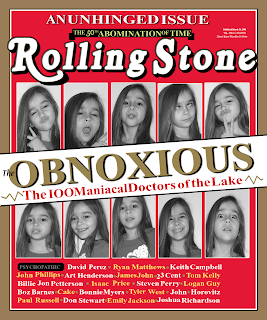
Thursday, June 4, 2009
Sunday, May 31, 2009
Tuesday, May 26, 2009
Vocabulary Definitons
1.Font: a specific size and style of type within a type family.
2.Type: Movable type is the system of printing and typography that uses movable components to reproduce the elements of a document (usually individual letters or punctuation).
3. Serif: A short horizontal line added to the tops and bottoms of traditional typefaces, such as Times Roman
4. San-Serif: In typography, a sans-serif or sans serif typeface is one that does not have the small features called "serifs" at the end of strokes
5. Italics: n typography, italic type /tælk/ or /atælk/ refers to cursive typefaces based on a stylized form of calligraphic handwriting. The influence from calligraphy can be seen in their usual slight slanting to the right
6. Stroke: A punctuation mark (/) used to separate related items of information, a mark made on a surface.
7. Glyph: A graphic symbol whose appearance conveys information; for example, the vertical and horizontal arrows on cursor keys that indicate the directions in which they control cursor movement.
8. Character: In computer and machine-based telecommunications terminology, a character is a unit of information that roughly corresponds to a grapheme, grapheme-like unit, or symbol, such as in an alphabet or syllabify in the written form of a natural language.
9. Script: A scripting language, script language or extension language, is a programming language that controls a software application. "Scripts" are often treated as distinct from "programs", which execute independently from any other application.
10. Ligature: A glyph representing a combination of two or more characters. In the Latin script, there are only a few in modern use, such as the ligatures.
11. Justification: In typesetting, justification (can also be referred to as 'full justification') is the typographic alignment setting of text or images within a column or "measure" to align along both the left and right margin. Text set this way is said to be "justified".
12. Open Type Fonts: Open Type is a scalable format for computer fonts, initially developed by Microsoft, later joined by Adobe Systems.
13. True Type Fonts: The True type Font format is used for storing vector fonts. It originated on Macintoshes and WinTel boxes and can be made to work on many others.
14. Post Script: Computer language created by Adobe Systems. PostScript allows a programmer to create complex pages using a series of commands. Text and graphics can be controlled with mathematical precision.
15. Leading: In typography, leading (, rhymes with heading) refers to the amount of added vertical spacing between lines of type. In consumer-oriented word processing software, this concept is usually referred to as "line spacing".
16. Kerning: In typography, kerning—less commonly, mortising (referring to the process of physically removing material from the cast character)—is the process of adjusting letter spacing in a proportional font.
17. Tracking: In typography, letter-spacing, also called tracking, refers to the amount of space between a group of letters to affect density in a line or block of text.



















































